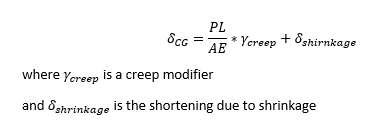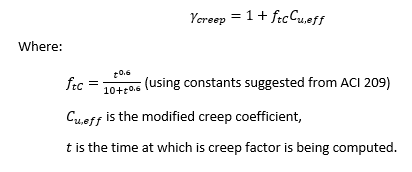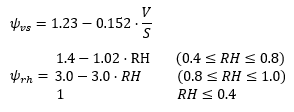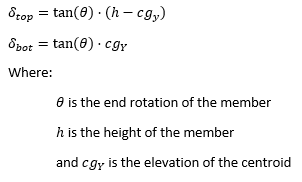Shortening
The shortening of members is caused by prestressing, shrinkage, and from flexure. The shortening at the centroid of the member is calculated using
The modifiers are calculated based on information from ACI 209. For this calculation, the elastic and inelastic shortening are added together. The inelastic shortening of the concrete is a combination of the creep of the concrete caused by the continued application of the prestressed force, along with the shrinkage of the concrete. This value is the shortening of the member that occurs between casting and erection of the precast member and can be assumed to be constant over the height of the cross section.
Creep Modifier
The creep modifier is a multiplier applied to the elastic shortening from first principals.
The creep coefficient, Cu, is defined as the ratio of the creep strain to the initial strain. A typical value for hardened concrete, according to ACI-209, is 2.35. This value is further modified by the volume to surface ratio (V/S) of the member and the relative humidity (RH) as follows:
Shrinkage Modifier
The shrinkage modifier is used to account for the member shrinking. This is produced using the ultimate strain in the concrete produced by shrinkage of the concrete. A typical value, according to ACI-209, is 780x10-6. This strain is used to estimate the total shortening as follows:
The shrinkage strain is further modified by the volume to surface ratio (V/S) of the member and the relative humidity (RH) as follows:
Flexure Effects
Flexure also effects the shortening at the ends of the member. For a member cambering up, this will make the top corners move further apart and the bottom corners moving closing together. This can be computed using some simple trigonometry as follows:
Hand Calculation
References
ACI Committee 209, ACI 209.2R-08, Guide for Modeling and Calculating Shrinkage and Creep in Hardened Concrete, American Concrete Institute, Detroit, 2008.





